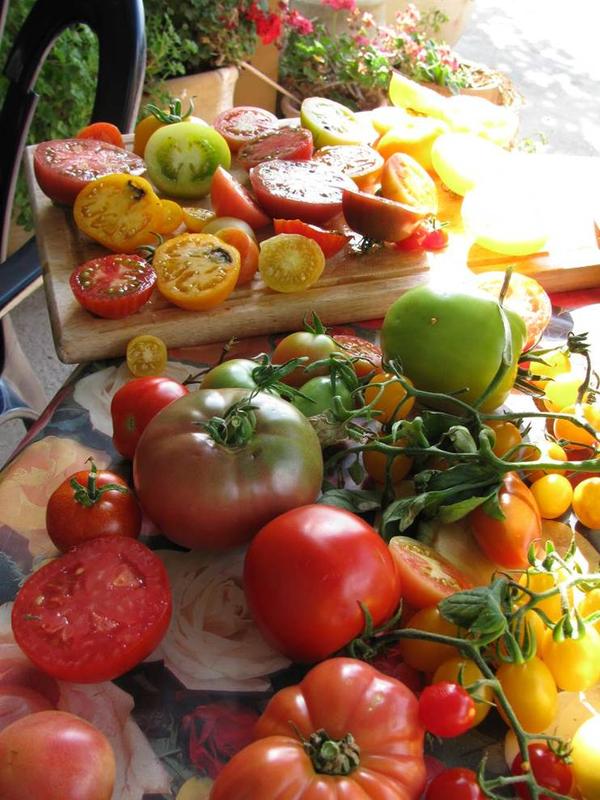What is insight the tomato? Breeding has had influenced the chemical composition of tomato fruits

Colourful mixture - Tomato breeding offers a wide variety MPI-MP, S. Osorio Algar
Tomatoes and their wild relatives
Originally, tomatoes are from South- and Middle-America, where the Mayas cultivated them. The origin of their wild relatives is located in the Andes. Here, wild tomatoes have small and partly bitter-tasting or even toxic berries. Tomatoes belong to the nightshade family (Solanaceae), which includes foods as potato and pepper, as well as toxic plants as belladonna.
So-called alkaloids are responsible for the bitter tasting/toxic compounds. The plant uses them to protect themselves against herbivores and pathogens. In the course of domestication and by modern breeding programs, the bitter tasting compounds of the tomato were reduced and larger fruits were selected.
Challenges in breeding
Genetic inheritance is a complex process and breeding of plants with respect to favored characteristics is a difficult exercise. The reason is that characteristics, as fruit size are influenced by more than one gene. Moreover, different versions of one gene can exist in one living organism. This is comparable to the variety of written forms of one sound.
For example, be, eat and see are written differently, but the letters e, ea and ee sound similar in these words. That is how the DNA code of genes can be written differently, which results in a variable characteristic value. In addition, the qualitative nature of characteristics is not only influenced by genes and their different versions, but also by environmental conditions.
New methods in plant research allow deeper analysis of breeding results
Staying with tomato, one can easily imagine that breeding of larger fruits has to be coupled to other changes in the plant. Not only an increase in fruit size by increasing cell number had to be implemented during the breeding process but also the chemical composition is adapted via the accumulation of higher amounts of metabolites or even with production of new compounds. As such, the enlargement of fruits has to be coupled to changes at the genomic level, including the DNA code, its transcription and translation into (metabolic) processes.
Modern techniques and analysis methods give the opportunity to study plants at different levels. Actually, that is what the research team has done in the current study. “We have analyzed and compared the genetic and metabolic composition of up to 610 tomatoes of different origin”, explains Alisdair Fernie.
The comparison of wild and cultivated tomatoes is decisive here, because small berry-like fruits of the wild species were transformed into red tomatoes, which were nearly hundred times larger. The breeding process passed through two main stages. First, the plants were domesticated and secondly, they were improved. The researchers found that these two phases seemed to have had a different influence on the chemical composition of the fruit.
Genes in the piggyback
With the help of comprehensive genome and metabolite analyses, the research team could show that the breeding phase to improve the plant had a stronger influence on the metabolite content. “We found two different selection mechanisms in this breeding phase. On one hand, the taste was bred directly, as fruits with less bitter taste were selected. Moreover, we found that fruit size is strongly associated with metabolites. In this manner, the taste was bred indirectly by selecting larger fruits”, Alisdair Fernie says.
It appears that the respective genes of the metabolism “hitchhike”! They are coupled to the genes responsible for fruit size and thus are genetically inherited together. Here, the researchers have excluded a direct influence of the fruit size genes on the metabolites. Therefore, it seems to be coincidental rather than the result of directed breeding that larger fruits contain better tasting metabolites.
Understanding of control mechanisms, improvement of breeding programs
The diverse data obtained give insights into the variation of the metabolism and its genetic and biochemical control mechanisms. The knowledge currently available about the chemical composition of tomatoes and their molecular biological relations could lead to an improvement of the fruit quality with corresponding breeding programs. Moreover, these data can be used in further detailed studies to analyze control mechanisms of tomato metabolism.
Contact
Prof. Dr. Alisdair Fernie
Max Planck Institute of Molecular Plant Physiology
Tel. 0331/567 8211
fernie@mpimp-golm.mpg.de
Dr. Ulrike Glaubitz
Public Relations
Max Planck Institute of Molecular Planz Physiology
Tel. 0331/567 8275
glaubitz@mpimp-golm.mpg.de
http://www.mpimp-golm.mpg.de
Original Publication
Guangtao Zhu, Shouchuang Wang, Zejun Huang, Shuaibin Zhang, Qinggang Liao, Chunzhi Zhang, Tao Lin, Mao Qin, Meng Peng, Chenkun Yang, Xue Cao, Xu Han, Xiaoxuan Wang, Esther van der Knaap, Zhonghua Zhang, Xia Cui, Harry Klee, Alisdair R. Fernie, Jie Luo, Sanwen Huang (2018).
Rewiring of the Fruit Metabolome in Tomato Breeding.
Cell, Volume 172, Issue 1, 249 – 261.e12. DOI: http://dx.doi.org/10.1016/j.cell.2017.12.019
Media Contact
All latest news from the category: Life Sciences and Chemistry
Articles and reports from the Life Sciences and chemistry area deal with applied and basic research into modern biology, chemistry and human medicine.
Valuable information can be found on a range of life sciences fields including bacteriology, biochemistry, bionics, bioinformatics, biophysics, biotechnology, genetics, geobotany, human biology, marine biology, microbiology, molecular biology, cellular biology, zoology, bioinorganic chemistry, microchemistry and environmental chemistry.
Newest articles

NASA: Mystery of life’s handedness deepens
The mystery of why life uses molecules with specific orientations has deepened with a NASA-funded discovery that RNA — a key molecule thought to have potentially held the instructions for…

What are the effects of historic lithium mining on water quality?
Study reveals low levels of common contaminants but high levels of other elements in waters associated with an abandoned lithium mine. Lithium ore and mining waste from a historic lithium…

Quantum-inspired design boosts efficiency of heat-to-electricity conversion
Rice engineers take unconventional route to improving thermophotovoltaic systems. Researchers at Rice University have found a new way to improve a key element of thermophotovoltaic (TPV) systems, which convert heat…



